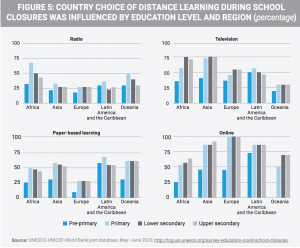Introduction
2020 is a special year for all of us. The Corona pandemic has caused the biggest disruption of the educational system in history (UN, 2020). For us as students that means that we participate in the European IFITT Masterclass on eTourism online, as well as spending the whole semester in front of the screen. Without ICT’s this wouldn’t be possible. Information and Communication Technologies (ICT) are more and more available, even in developing countries. Since the 1980’s it is believed that ICT’s are a magic bullet that improves learning and education (Cuban, 2004). This can include education in tourism and hospitality. But can ICT really improve the learning quality? Or do they increase the “digital divide”? (Wagner, 2017).
The United Nations have declared 17 sustainable development goals in order to transform our world. One of them is quality education (UN, 2020). Once more, the pandemic has shown us how important ICT’s are in terms of education. Current figures show that over 1.6 billion people have been out of school in times of corona – which has an impact on over 91 per cent of the students around the globe (UN, 2020). The German government has just provided a quarter billion Euros to digitalize German schools (Bundesregierung, 2020). In Mexico the classes are held via TV, as it is the medium which has the biggest reach.
The world of education before Covid-19
The educational systems around the globe have always been facing intimidating challenges in order to force quality education as a human right. According to data of 2018, over 250 million children are out of school and over 850 of them are illiterates (UIS, 2018). Yet being in school does not guarantee a quality education, as around 387 million children lack basic reading skills (UIS, 2017). From a financial point of view, in the beginning of 2020, an estimate of 148 billion dollar will be missing to fulfil the SDG N. 4 – Quality Education (UNESCO, 2020).
The world of education during Covid-19
As mentioned earlier, the impact of the pandemic on the educational system has reached an unimagined extent. Many educational institutes aimed to maintain programs through online schooling. However, ownership is a major limitation for access to distance learning. Many students in developing countries do not have access to the internet nor do they possess a personal computer or tablet. The pandemic therefore disservice education and limits the aims of the SDG No. 4. This causes the need for more childcare, higher economic costs and the dropout rate of schools worldwide (Filho et al., 2020).
Many governments reacted quickly to the pandemic by closing the schools, protecting the pupils and, on the other hand, trying to support the continuation of the learning process online through online educational platforms (Jandric, 2020). However, the unequal allocation of learning conditions during the closures will likely increase the inequality of education in the long term (UN, 2020). The next graphic shows the most common practices and tools used for distance learning during the pandemic (mostly ICTs). As visible, distance learning in high income countries is estimated to have a 80-85% reach, whereas data of low income countries show a reach of less than 50% (TCG, UNESCO, 2020).

An example on how ICT can improve education
Putting the pandemic aside and taking a concrete look on how ICT can be implemented into education, an experiment in Niger has tested the ability to learn with mobile phones. A problem emerged with adult education was the low level of enrolment and the high dropout rates (Ortega and Rodriguez, 2008). Nevertheless, the results of a study by Aker confirmed that mobile phones can be an effective and low-cost tool to improve educational outcomes. Furthermore, they can be used in rural areas and be utilized in daily life. Yet there are many factors that can influence a positive impact on the quality of education, such as telecommunication infrastructure, educational materials available in the mother tongue and the price (Aker et al., 2012).
Conclusion
Overall, it is fair to say that ICTs have brought new dynamics into the education sector, offering a lot of opportunities in order to reach the fourth goal of the SDGs – Quality Education. Yet it also brings threats to people with low income. As ICTs usually involve an economic factor, this can lead to a so called ‘digital divide’. Furthermore, the Covid-19 pandemic was a complete game changer to the whole world, but also for the educational system around the globe (including education in tourism and hospitality). Over 1.5 billion pupils were out of school. Therefore, we must be careful and not compromise the education of a whole generation due to this crisis. Nevertheless, ICT has shown that it can compensate regular schooling in some parts, and it can play a major role in the future by providing access to knowledge and making the world more sustainable.





